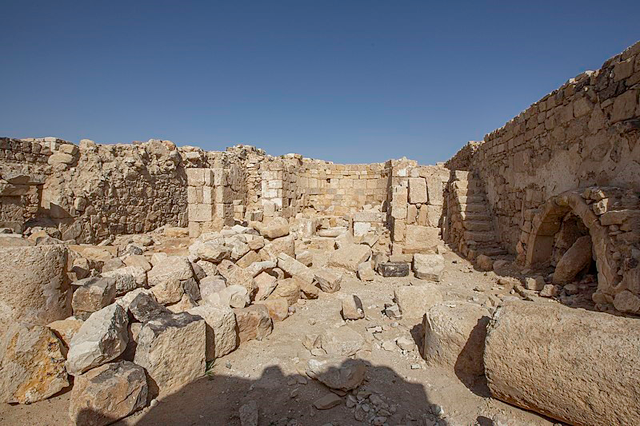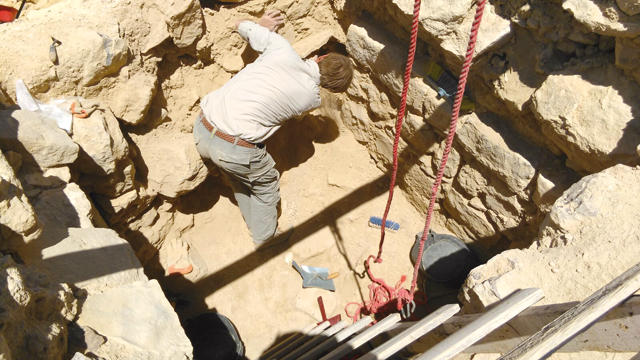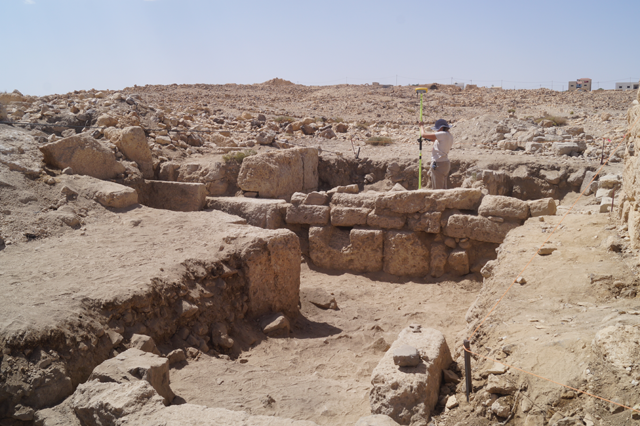You are here
Highlighting Dutch-Jordanian archaeological cooperation in Udhruh
By Saeb Rawashdeh - Oct 08,2024 - Last updated at Oct 08,2024

A shaft dug in Udhruh where a team of archaeologists analysis how ancient inhabitants of the area harvested water (Photo of Saeb Rawashdeh)
MAAN — Udhruh is a site located some 15 kilometres east of Petra and represents an open laboratory in water management. The area was occupied during the Nabataean period and ancient inhabitants of Petra and its hinterland were very skilful in water harvesting and water storage.
In the 21st century, water scarcity and irrigation in very arid areas posed a challenge for communities who live of husbandry.
Dutch and Jordanian scholars teamed up and studied different techniques of the water management in the dry environment of Udhruh. In 2011, the University of Hussein Bin Talal in Maan and Leiden University launched a joint Udhruh Archaeological Project led by the professors Fawzi Abudanah and Mark Driesen.
Meanwhile, the embassy of The Netherlands has supported the research project because they believe that Jordan, but also humanity as a whole, stand to learn so much from the past.
"It is a wonderful thing to show to people the impact of this project. We follow the line that both professors have in mind and we as embassy support the project," said Dutch Ambassador to Jordan Harry Verweij.
"There are also two Jordanian students who are doing a survey in terms on how Udhruh could become a touristic destination. Lot of people go to the Golden Triangle and this could also be a model for tourism and attract more people," said Senior Press and Cultural Affairs Officer Seema Huneidi, adding that it should be seen how visits to Wadi Rum can be linked with a journey to Udhruh.
The aim of the project is to strengthen the position of Dutch archaeological research in Jordan, to develop a sustainable relationship between the Dutch and Jordanian archaeological communities and researchers, and to promote cross-cultural cooperation and encourage collaboration between The Netherlands and Jordan in the field of excavations and archaeological research.
People in the past were aware on how to organise water harvesting in areas like Udhruh, noted the scholar Driessen during a tour of the site.
"Udhruh has housed an earlier Nabataean site and was occupied continuously throughout the Byzantine and Islamic periods, with all intriguing cultural, socio-economical and religious transformation processes concerned. These processes can be followed not only on the site itself but also in a surrounding landscape with limited disturbance caused by later human activities," Driessen underlined.
Scholars from Hussein Bin Talal in Maan and Leiden University have been studying precipitation in the ancient times trying to connect it with more recent periods.
"People in the past applied structures and the runoff catchment systems to harvest water. Creating dams and terraces helped in that regard," Driessen said, adding that such structures can be seen west, north and northwest of Udhruh. Jordan is a country with some of the oldest irrigation systems and it goes before the Nabataean times, some 9,000 years ago, Driessen underlined.
There is also a canal system in Udhruh that enabled its inhabitants to preserve water."Some of these aquifers contained 100 000 million of litres of water, Driessen said, adding that the archaeological team found 231 shafts. Shafts were made for construction, maintenance and ventilation," the professor said.
Related Articles
AMMAN — Professor Fawzi Abudanah from Al Hussein Bin Talal University in Maan conducted survey at Udhruh, a site located some 15 kilometres
AMMAN — Udhruh, some 15 kilometres east of Petra and known from the Nabataean, Roman and Byzantine times, is a place where Jordanian and Dut
AMMAN – The area around the Nabataean and later Roman site Udhruh is covered with a network of smaller sites and watchtowers.


















